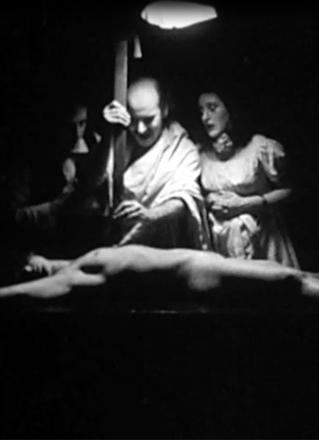 The first feature by Argentina’s Miguel Bejo, a figure who deserves to be ranked with cinematic provocateurs like Jodorowsky and Arrabal, and probably would were his films not so obscure. THE UNITED FAMILY AWAITS THE VISIT OF HALLEWYN (La familia unida esperando la llegada de Hallewyn) hails from 1971, and despite enthusiastic film festival reception was denied a commercial release by the Argentine government (Bejo’s 1979 follow-up BETO NERVIO CONTRA EL PODER DE LAS TINIEBLAS was similarly neglected).
The first feature by Argentina’s Miguel Bejo, a figure who deserves to be ranked with cinematic provocateurs like Jodorowsky and Arrabal, and probably would were his films not so obscure. THE UNITED FAMILY AWAITS THE VISIT OF HALLEWYN (La familia unida esperando la llegada de Hallewyn) hails from 1971, and despite enthusiastic film festival reception was denied a commercial release by the Argentine government (Bejo’s 1979 follow-up BETO NERVIO CONTRA EL PODER DE LAS TINIEBLAS was similarly neglected).
Loosely based on the 1934 play SIRE HALLEWYN by Michel de Ghelderode, the setting of THE UNITED FAMILY… is a large castle-like structure. There a couple who initially appear to be man and woman are revealed, in what was probably quite a shocking development in 1970, to be two men, one of them in drag. They’re in the act of getting dressed, and in quite a hurry because “they’re listening to us…”
Cut to the “United Family” of the title, an uber-wealthy clan whose ranks include the trans man from the opening scene, sitting down to a banquet. During the meal the discussion turns to a mysterious figure known as Hallewyn (Osvaldo do la Vega), who’s been exiled but is on his way back. After dinner the family descend into the basement for a visit to the grave of their long-deceased matriarch, only to discover the crypt breached and the corpse stolen.
The family patriarch (Osvaldo de la Vega, again) reacts by calling a press conference in which he addresses the camera directly, discussing not the theft of the corpse but how his is a peaceful family “founded on principles of Western Christian morality.” He promises that the evil Hallewyn, who previously disrupted the family’s harmony, will assuredly be “defeated by the forces of good.”
From there the family sinks into depravity while eagerly awaiting the arrival of Hallewyn. He eventually turns up, revealing himself as a wimpy sort who’s far from the imposing monster we’ve been primed to expect. Nor do the “good” and “evil” designations put forth by the father hold true, as while a patriotic Argentine war anthem plays on the soundtrack the apparently upstanding family patriarch is revealed to be a vampire.
The idea of a long-absent icon being felled by vampires will resonate with anyone familiar with the history of Argentina, which was here given a symbolic interpretation (the word “United” in the title indicates its political overtones). Hallewyn represents the late Argentine President Juan Perón (with his wife Eva symbolized by the deceased family matriarch), who in 1971 was in exile, with the Argentine public eagerly awaiting his return. The film’s ending proved quite prophetic, as Perón, upon returning to his home country in 1973, was elected for a second term, only to die the following year—after which Argentina was overtaken by a military junta, ushering in (as stated by Bejo) “a society that exercised cultural vampirism by which a culture was absorbed, deformed and never emerged on its own.”
The problem with this symbolism-heavy approach is that the film’s components don’t hold together outside the symbolism. We never learn much about Hallewyn and his hold on the family, nor the “outside” people (the population of this film’s universe being divided into the interior-dwelling rich folk and the proletariat outside), who have a more optimistic perspective on Hallewyn’s arrival.
Not that Bejo was ever too concerned with conventional storytelling. He claims to have adapted the Ghelderode play “from memory” and “lost the script on the first day of shooting,” improvising much of the remainder on the film, which is all-too-evident (it’s been claimed that during a 2003 screening at the Mar del Plata Film Festival around 70 percent of the audience left before the end).
The film is packed with innovative and overtly postmodern touches, such as characters breaking the fourth wall and discussing the plot construction. Hallewyn’s impending arrival is depicted by clips of Christopher Lee riding a horse from Mario Bava’s WHIP AND THE BODY/ La frusta e il corpo (1963) and Ennio Morricone’s theme music from that film (Bejo claims he got authorization from the distributor), while an obvious painting is used as an establishing shot of the gothic structure where the film takes place and plot points are conveyed by handwritten notes. Those latter elements showcase Bejo’s resourcefulness, which leans into rather than fights against the limited resources.
Bejo’s aims were myriad: a horror movie deconstruction, a symbolic depiction of early 1970s Argentina, a sex and scatology packed shock fest (which fully earns its “underground” designation) and an avant-garde manifesto (with Bejo’s cult filmmaker fellows Edgardo Cozarinsky, Julio César Ludueña and Bebe Kamin employed as cast and crewmembers). Hence the film’s major issue: Bejo and his collaborators simply had too many ideas. But too many ideas is better than, as is the case with so many modern films, too few.
Vital Statistics
THE UNITED FAMILY AWAITS THE VISIT OF HALLEWYN (La Familia unida esperando la llegada de Hallewyn)
Director: Miguel Bejo
Producers: Miguel Bejo, Rosalba Orena
Screenplay: Vicente Battista, Miguel Bejo, Osvaldo de la Vega, Roman Garcia Azcarate
(Based on a play by Miguel de Ghelderode)
Cinematography: Carlos Sorin
Editing: Julio Di Risio
Cast: Osvaldo de la Vega, Alberto Ferreiro, Eduard Giri, Jorge Hayes, Maria Elena Moby, Judith Cingolano, Rolando Revagliatti, Edgardo Cozarinsky, Julio César Ludueña
